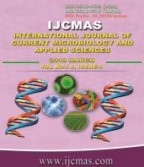


 National Academy of Agricultural Sciences (NAAS)
National Academy of Agricultural Sciences (NAAS)

|
PRINT ISSN : 2319-7692
Online ISSN : 2319-7706 Issues : 12 per year Publisher : Excellent Publishers Email : editorijcmas@gmail.com / submit@ijcmas.com Editor-in-chief: Dr.M.Prakash Index Copernicus ICV 2018: 95.39 NAAS RATING 2020: 5.38 |
A series of laboratory and greenhouse experiments were conducted at the Environment, Natural Resources and Desertification Research Institute (ENDRI), National Centre for Research (NCR) and College of Agricultural Studies, Sudan University of Science and Technology (SUST), Sudan, to examine the efficacy of the fungus Trichoderma harzianum, culture age, inoculum type, application time, fungal extract, compost and bacterial strain on Striga hermonthica germination and sorghum infestation. The highest significant (P≤0.05) inhibition on S. hermonthica germination was obtained at 10 days by T. harzianum culture as compared to both controls. Application of all T. harzianum aqueous and ethyl acetate extracts concentrations significantly (P≤0.05) reduced S. hermonthica seed germination as compared to the corresponding control. T. harzianum inoculum extracted by ethyl acetate reduced germination by 97%. T. harzianum aqueous 100% induced germination during conditioning by 64 % in response to GR24 (0.1ppm). All types of T. harzianum inoculum (Autoclaved, culture and filtrate) significantly (P≤0.05) reduced germination, with application of T. harzianum culture filtrate gave the highest reduction on germination as compared to control and other inoculums. Application of the 3 inoculums at 2 hours reduced germination percentage more than at 4 hours. Filtrate and culture inoculums at 2 hours reduced germination by 79 and 68%, respectively. The combination of compost 100%+ T. harzianum + BMP+Flavobacterium reduced germination by 68%. The greenhouse results showed that the combination of compost plus BMP+ Flavobacterium gave lowest number of S. hermonthica emergence and the highest sorghum plant height. The combinations of compost with T. harzianum and with BMP+ Flavobacterium significantly reduced S. hermonthica dry weight, increased sorghum shoot and root dry weight insignificantly as compared to the control.
 |
 |
 |
 |
 |